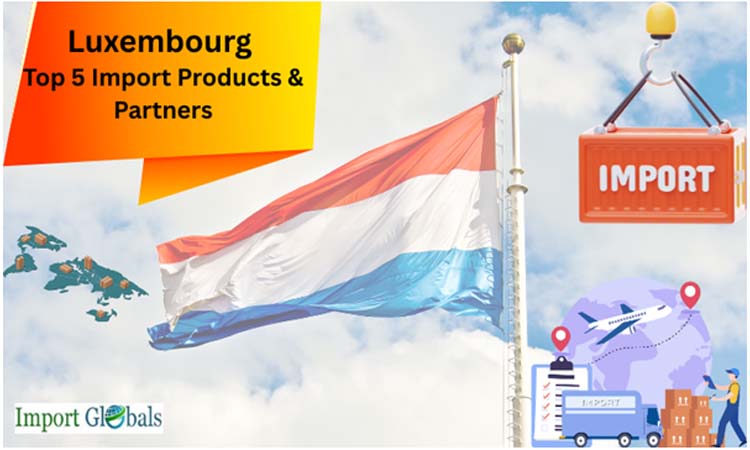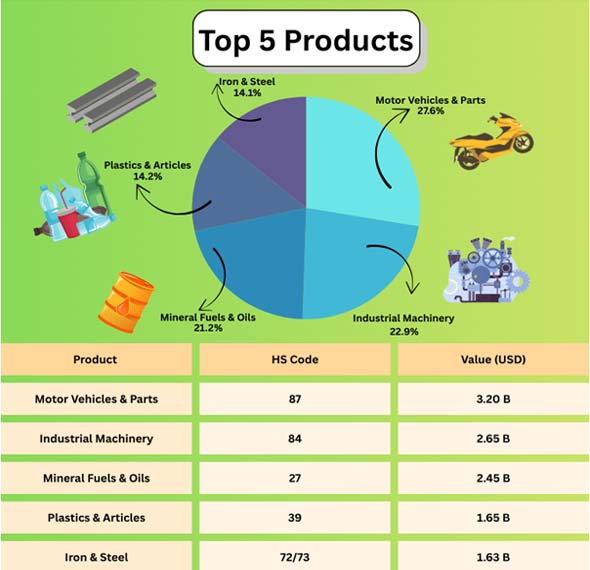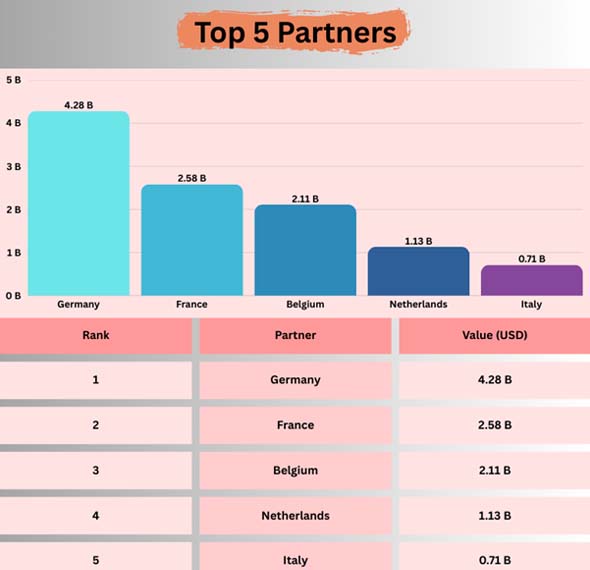
- Nov 03, 2025
The Top 5 Import Partners & Products From Luxembourg
Its overseas trade helps a lot with its service-oriented industries and domestic consumption. The country imports a lot of products compared to its GDP, since it is in the middle of Europe and is a center for cross-border migration.
According to Europe Export Data, Luxembourg buys around $25–26 billion worth of products each year, mostly from other countries in the European Union.
This blog looks at Luxembourg's five most important trading partners and the items that come into the country. It does this by using statistics, new information, and structured opinions.

The Five Most Popular Imports
Luxembourg's imports are mostly made up of manufactured products, machinery, cars, and energy items, even if they are all different. Below are the most popular product groups:
1. Cars and Parts
According to Import Globals' Luxembourg Import Export Trade Data, cars and car parts make up most of Luxembourg's imports. The country buys a lot of trucks, cars, and auto parts from other countries. This is because businesses and people both buy a lot of these things. Luxembourg has a high per capita income, which makes premium automobiles quite popular. Vehicles are worth $3.20 billion in imports, which is more than 13% of all imports.
2. Machines used in factories
Based on Luxembourg Import Data from Import Globals, machinery and mechanical appliances are the second-largest category, with an estimated value of USD 2.65 billion, or around 10.6% of imports. These include computers, factory equipment, and other tools needed for building infrastructure, setting up company offices, and making things.
3. Fuels and Oils from Minerals
Luxembourg needs to import a lot of energy because it doesn't make any of its own. Refined petroleum products and related energy goods make up around 9.9% of imports, which is worth $2.45 billion. People use these fuels for transportation, for their own use, and to some extent to send to surrounding countries.
4. Plastic and Paper Products
According to Import Globals' Luxembourg Import Trade Analysis, both raw and finished plastics are brought into the country to help the light manufacturing, building, and packaging industries. About $1.65 billion, or 6.6% of all imports, comes from other countries.
5. Iron and Steel
According to Import Globals' Luxembourg Export Data, the steel industry has been around for a long time in Luxembourg, and iron and steel imports are still significant for building and industrial uses. This group of items is worth roughly 1.63 billion USD, or about 6.5% of total imports.

The Five Most Important Import Partners
Luxembourg's imports come largely from EU countries because it is in the middle of Europe and relies on commerce with other EU countries.
1. Germany
According to Germany Import Data, Germany is Luxembourg's top trading partner, bringing in $4.28 billion, or around 17.2% of all imports. Most of the things that Germany buys from other countries are industrial goods, machines, and cars.
2. France
According to Import Globals' study on Europe Import Trade Statistics, France is the second-largest supplier of goods to Luxembourg, sending products worth $2.58 billion. Imports of consumer goods, oil, and machinery are quite essential.
3. Belgium
Belgium Import Data shows that it is an important trading route since it has a lot of manufactured goods, power, and fuel. Belgium sends around 8.5% of Luxembourg's imports, which is $2.11 billion.
4. The Netherlands
Import Globals' research of the Netherlands Import Data shows that the country sends out refined fuels, chemicals, and re-export goods. The Netherlands is responsible for 4.5% of Luxembourg's imports, which is worth USD 1.13 billion.
5. Italy
Italy sends Luxembourg cars, consumer items, and equipment. Imports from Italy make up around 2.9% of the total, or USD 710 million.

Why these Partners and Products?
Luxembourg's commercial profile is shaped by its industrial base, its geography, and its participation in the EU. Luxembourg is landlocked and relies on its neighbors for energy and consumer goods. That's why Germany, France, and Belgium send most of their commodities.
Luxembourg Export Import Global Trade Data states that vehicle and equipment comprises most of the country's exports and imports. There is a requirement for home market as well as trade partners. Since there are no reserves of renewable energy in the nation, fossil fuels are essential. Industries such as construction, infrastructure, and packaging rely on imported steel and plastic.
Future Plans
Energy prices: Oil and gas prices fluctuate on a global scale. This means that the energy budget of Luxembourg will be impacted indefinitely.
Changing Times in the Auto Industry: The popularity of electric vehicles could slowly change how cars are introduced in the home market.
Needs for Machines: Many parts of industrial machinery will have to be brought in from other countries because of digitalization and automation.
People in the EU region may want clean energy sources. They do not want to rely on fossil fuels from other countries because of environmental considerations.
Final Reflections
You can analyse that it is an open economy. It is a member of the European Union. A big part of the trade is made up of imported goods like steel, cars, tools, fuel, and plastics. This kind of goods is mostly made in Italy, the Netherlands, Belgium, Germany, and France. Close ties and being a member of the European Union are both crucial. Future technological developments and changes in EU environmental regulations may affect Luxembourg's trading practices. Import Globals is a leading data provider of Luxembourg Import Export Trade Data. Sign up for Import Globals to get more information on commerce throughout the world!
FAQs
Que. What is the biggest thing that Luxembourg buys from other countries?
Ans. About 13% of all imports are motor cars and parts, which is the biggest group.
Que. Who are three countries that Luxembourg import the most from?
Ans. The top three partners are Germany, France, and Belgium.
Que. Do most of Luxembourg's imports come from EU countries?
Ans. Yes, almost 87% of imports originate from EU partners.
Que. What is the value of Luxembourg's imports per year?
Ans. Every year, Luxembourg buys items worth about USD 25–26 billion.
Que. What are some good places to obtain detailed information on Luxembourg Import Data?
Ans. You may get more information on current data at www.importglobals.com or by sending an email to info@importglobals.com.
